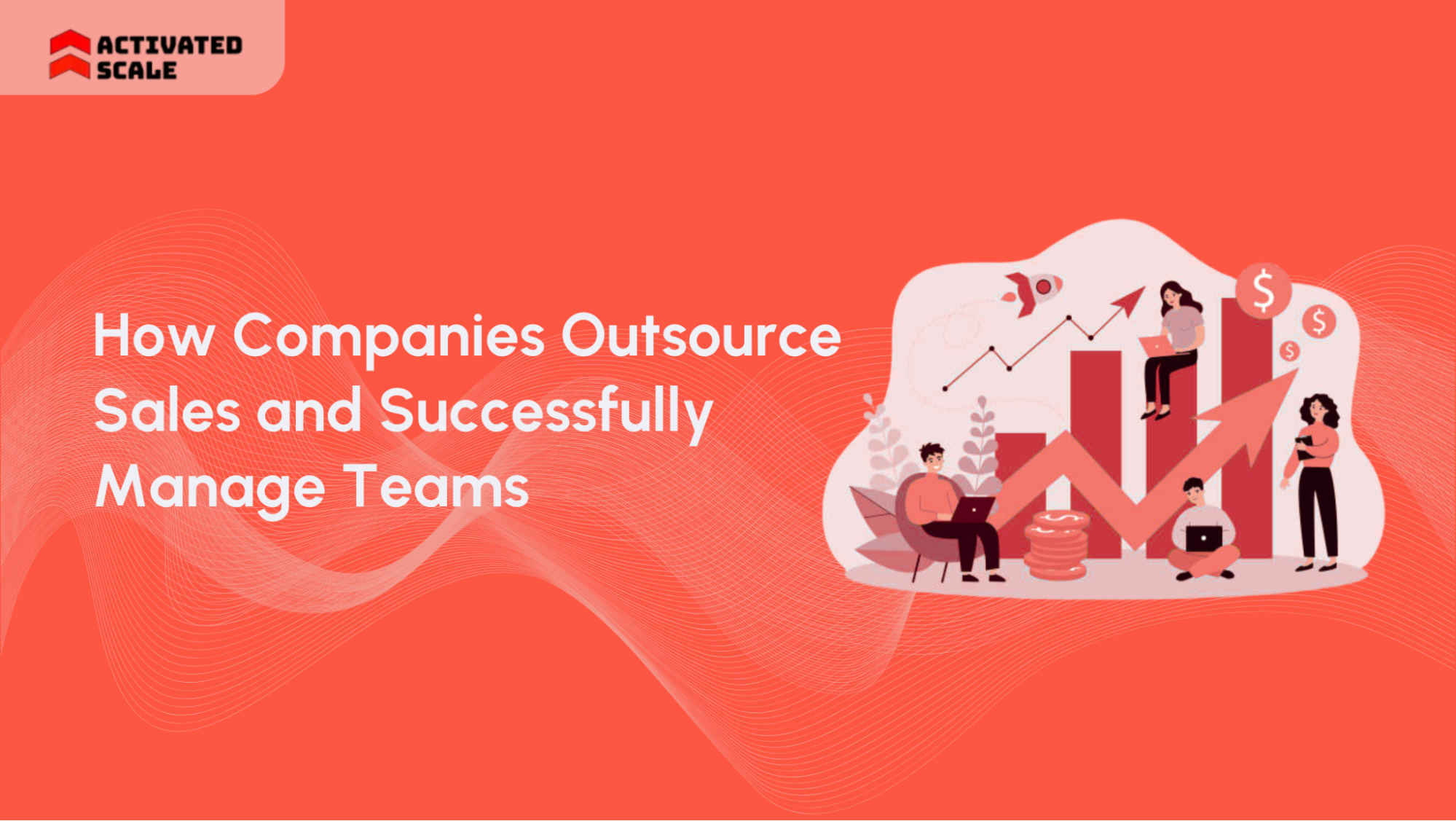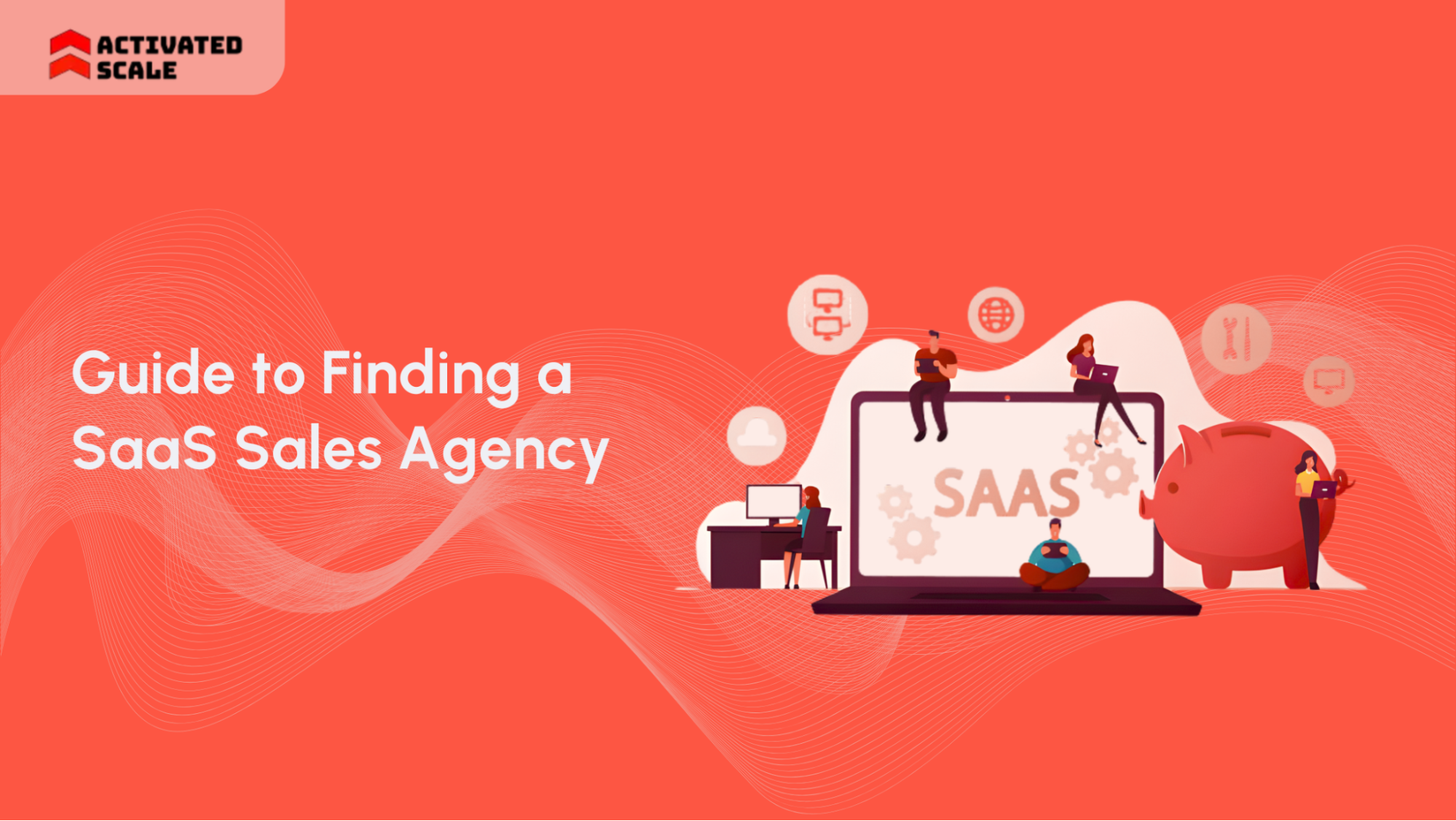Hiring high-quality sales teams remains one of the steepest challenges for businesses today. Finding skilled reps who fit your culture, understand your market, and deliver consistent results is a costly, time-intensive process.
For fractional SDRs, AEs, and VPs of Sales, relying solely on internal hires can slow down growth and drain critical resources. That’s why many companies look to outsource sales, using external experts to expand outreach effectively while maintaining control. But how companies outsource sales and manage dispersed teams without losing focus or quality?
In this guide, discover how leading firms go through the complexities of sales outsourcing to sustain pipeline momentum and align internal and external efforts for maximum impact.
Key Takeaway
- Cost Savings and Scalability: Outsourcing converts fixed hiring and infrastructure costs into flexible expenses, allowing businesses to scale sales efforts without long-term commitments.
- Access to Specialized Talent and Technology: Companies gain experienced fractional SDRs, AEs, and VPs using advanced CRM tools and outreach methods to boost sales pipeline quality and quantity.
- Flexible Engagement and Risk Reduction: Month-to-month contracts and service tiers let businesses test, expand, or pause sales efforts quickly, minimizing employer liability and overhead.
- Collaboration and Alignment: Shared CRM access, clear communication, and regular check-ins between internal and outsourced teams maintain consistent messaging and smooth lead handoffs.
- Data-Driven Performance Management: KPIs like connect rate, conversion, and pipeline size are tracked to optimize campaigns continuously, ensuring transparent ROI and agile adjustments.
What Does Outsourcing Sales Mean? And How Does it Work?
Outsourcing sales means contracting an external agency or professionals to execute part or all sales activities, from prospecting to closing deals, without growing your full-time, in-house team.
This method is increasingly adopted by US organizations for scaling pipeline, reducing overhead, and accessing specialized talent, including Fractional SDRs, AEs, and VPs of Sales.
How Outsourcing Sales Works
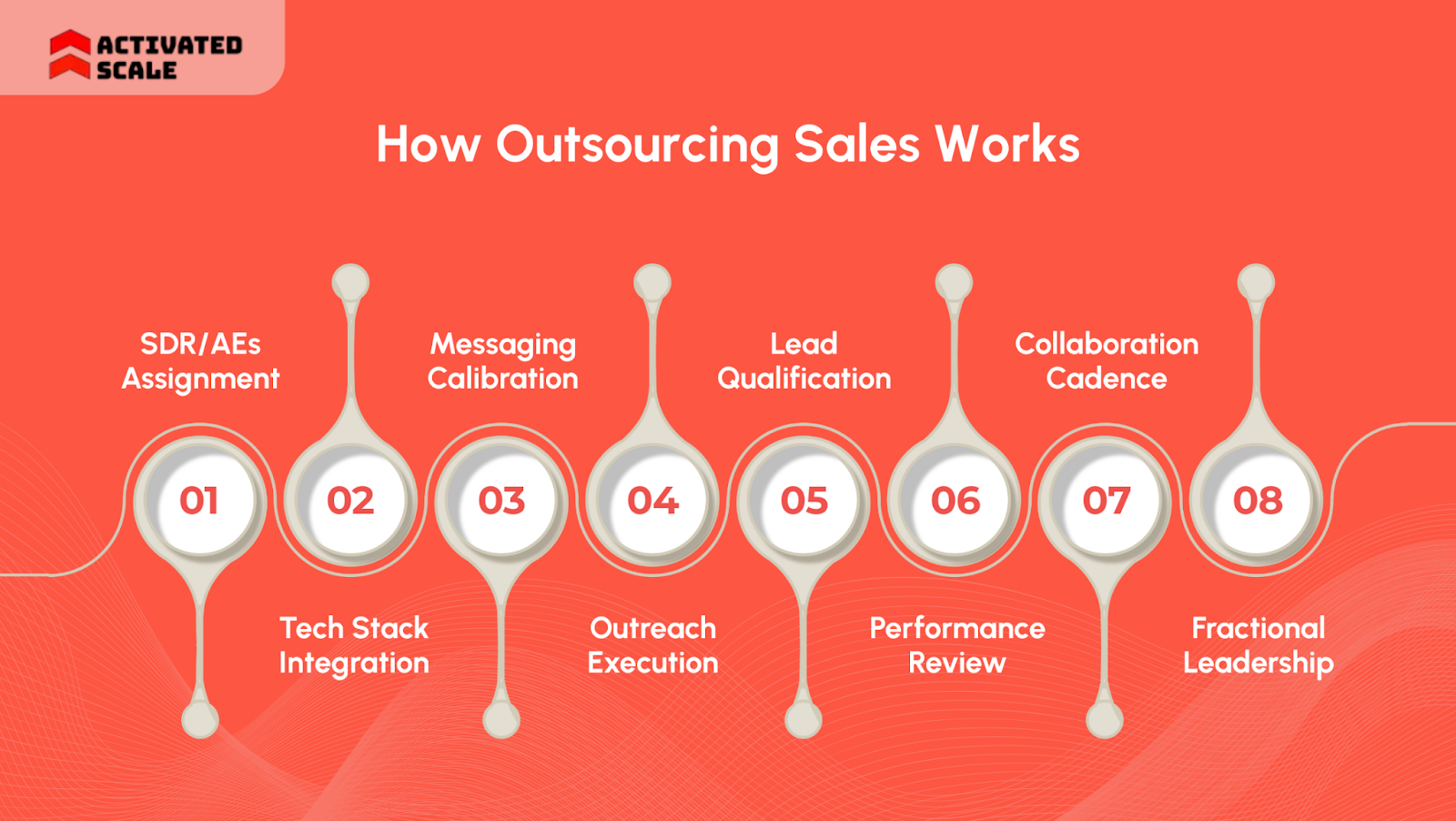
Here’s a clear look at how outsourcing sales functions in practice.
- SDR/AEs Assignment: External professionals with relevant industry experience are assigned to handle prospecting and lead nurturing, functioning as an extension of the sales function.
- Tech Stack Integration: External teams operate within company-approved CRM systems, dialers, and analytics platforms for transparency and real-time reporting.
- Messaging Calibration: Sales scripts, objection handling templates, and outreach rhythms are established to align with brand standards and audience engagement preferences.
- Outreach Execution: Daily campaigns use multi-channel strategies including cold calls, email, social selling, and inbound qualification to generate opportunities.
- Lead Qualification: Outsourced SDRs apply pre-set criteria to filter prospects, handing off sales-ready leads to in-house closers or maintaining continuity with Fractional AEs.
- Performance Review: KPIs, such as connect rate, pipeline size, conversion rate, and cost per acquisition, are tracked to validate partner impact and adjust tactics.
- Collaboration Cadence: Weekly dashboards and scheduled syncs keep the client’s leadership in control while allowing fast pivots and ongoing strategy refreshes.
- Fractional Leadership: Fractional VPs of Sales provide strategic guidance on process, team development, and market expansion, supporting founders and sales managers on a retainer basis.
What are the Benefits of Outsourcing Sales?
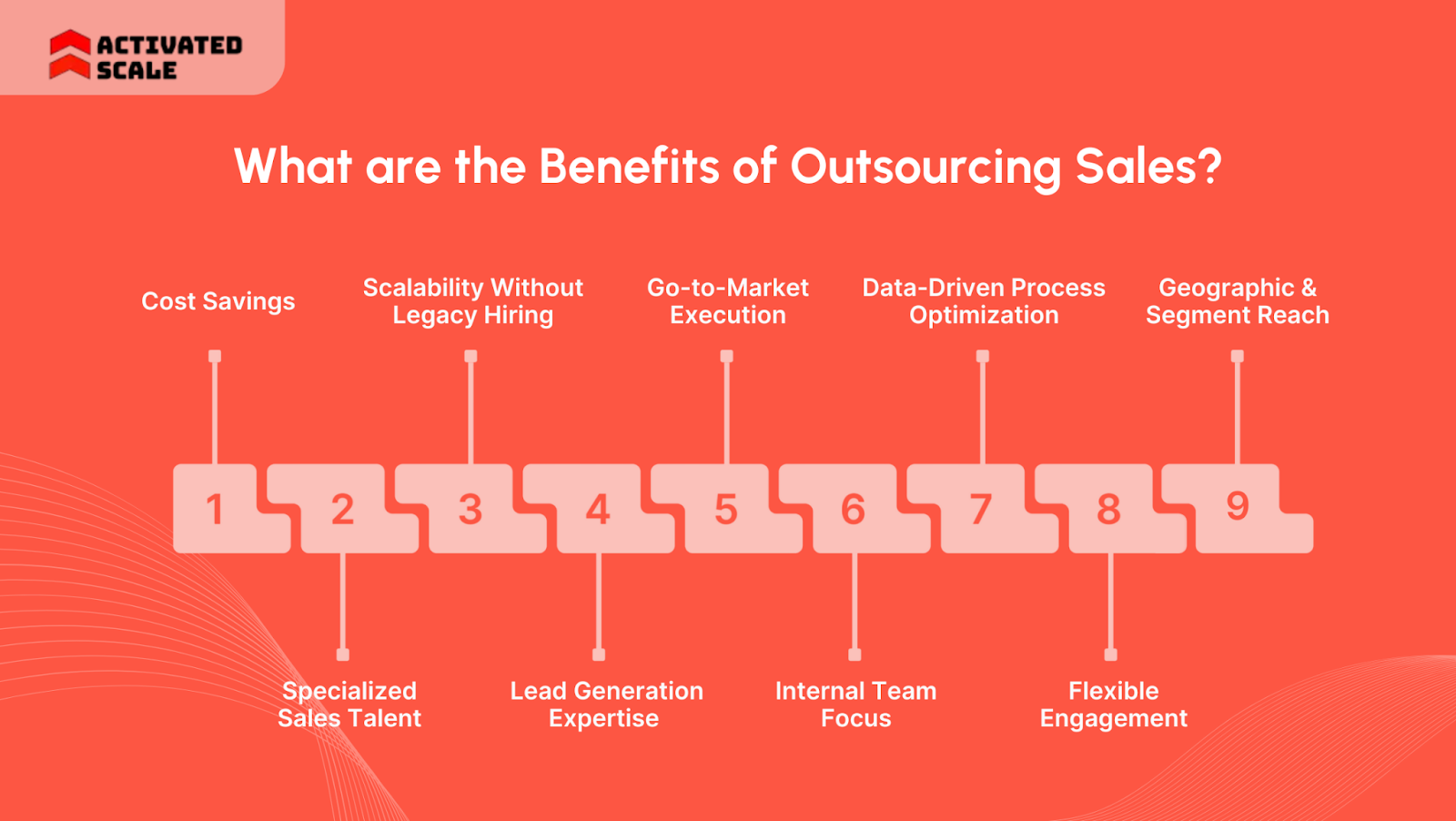
Outsourcing sales calls can free up resources while tapping into skills and tools already proven in the field. This approach often brings a sharper focus to both expanding reach and improving results without adding internal workload. Here are the key benefits to consider:
- Cost Savings: Outsourcing reduces expenses tied to recruitment, salary, benefits, training, and infrastructure, converting fixed costs into manageable pay-as-needed spending.
- Access to Specialized Sales Talent: External SDRs and AEs bring proven methodologies, industry context, and advanced prospecting tactics that drive high-quality pipeline growth.
- Scalability Without Legacy Hiring: Businesses can scale outreach quickly or pause engagement without onboarding, layoffs, or complex contract negotiations when markets fluctuate.
- Multi-Channel Lead Generation Expertise: Outsourced professionals tap advanced CRM, dialers, and proven outreach strategies to increase connect rates and qualified meetings for diverse sectors.
- Accelerated Go-to-Market Execution: External teams use infrastructure, messaging, and outreach processes that compress ramp times and move from pilot to pipeline in weeks.
- Internal Team Focus: In-house account executives and sales leaders spend less time prospecting and more on closing, upselling, and relationship management with high-intent buyers.
- Data-Driven Process Optimization: Sales outsourcing agencies deploy A/B testing and analytics to adjust campaigns, refining touchpoints without lengthy internal approval cycles.
- Flexible Engagement Models: Month-to-month contracts and adjustable service tiers let businesses trial expansions or pivots without risk of sunk employer liability.
- Geographic and Segment Reach: Outsourcing offers instant access to representatives in new territories and segments, allowing fast entry into verticals or regions outside core expertise.
Scaling sales doesn’t have to mean doing it all alone. Explore smarter ways to grow in this Benefits and Guide to Outsourced Sales Management.
Top Ways on How Companies Outsource Sales
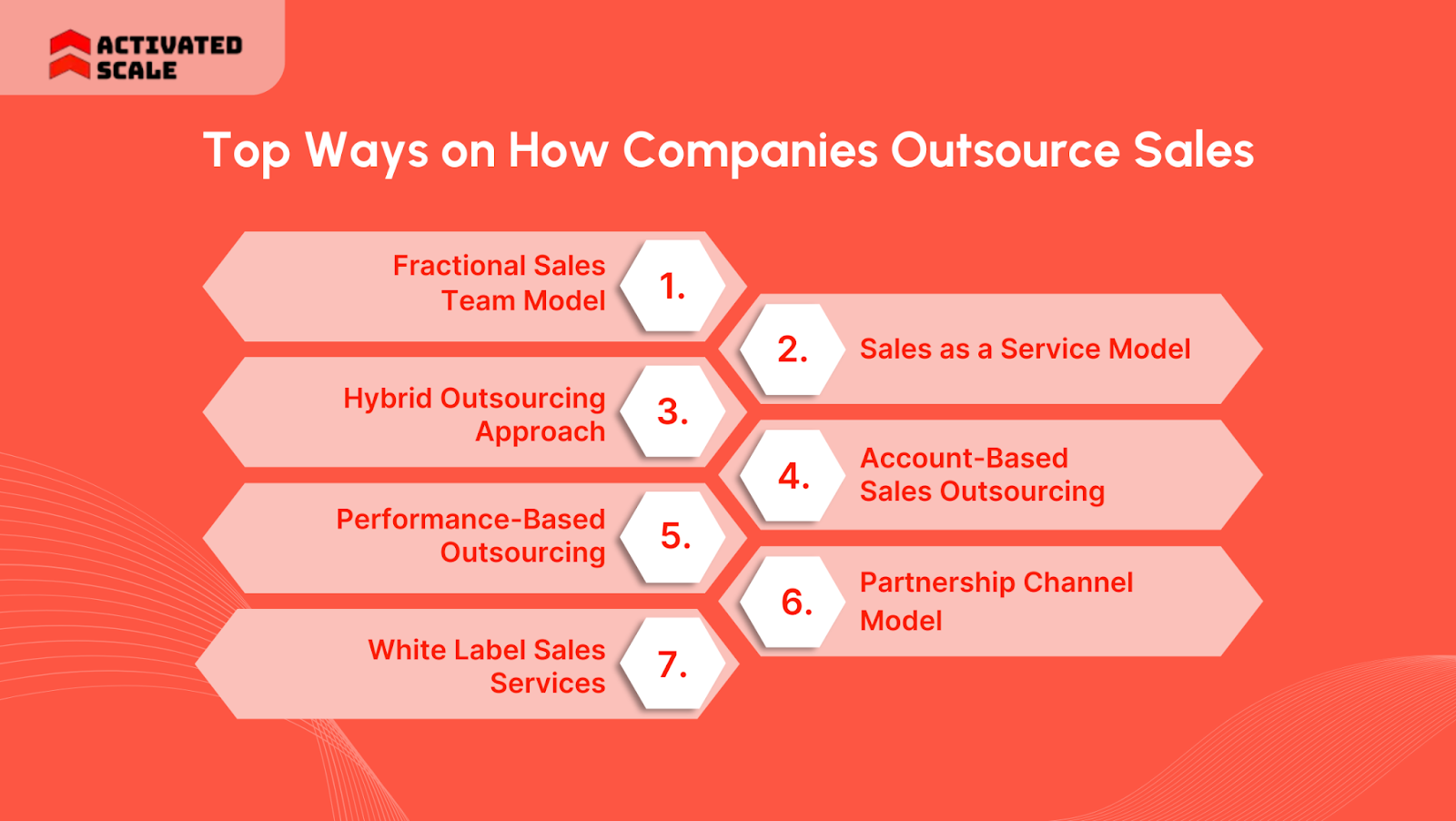
Companies seeking growth without internal overhead increasingly turn to sales outsourcing as their primary revenue acceleration strategy. From startups to enterprise organizations, how companies outsource sales depends on their specific growth objectives, budget constraints, and market requirements.
1. Fractional Sales Team Model
Companies contract specialized sales professionals on a part-time basis, typically 15-20 hours per week for 3-6 months. This approach provides immediate access to trained talent without full-time commitments.
Key tips:
- Clear Goal Definition: Establish specific KPIs, like 15 SQLs quarterly from fractional SDRs, to create accountability.
- Proper Onboarding: Treat fractional hires like full-time employees with comprehensive product training and access to recorded calls.
- Performance Tracking: Monitor performance metrics such as lead-to-meeting rates, pipeline velocity, and CRM data accuracy for continuous improvement.
2. Sales as a Service (SaaS) Model
Organizations partner with external providers to handle entire sales functions, from lead generation through deal closure. This comprehensive approach eliminates internal infrastructure requirements while providing immediate market access.
Key tips:
- Vendor Selection: Choose providers with proven industry experience, transparent pricing, and performance-based compensation models.
- Technology Integration: Ensure smooth CRM integration and shared dashboards for complete visibility into campaign performance.
- Cultural Alignment: Verify outsourced teams understand messaging, tone, and brand values through training programs and style guides.
3. Hybrid Outsourcing Approach
Companies combine internal strategic functions with outsourced execution tasks. Internal teams handle high-value relationships while external teams manage scalable activities like lead qualification and outbound prospecting.
Key tips:
- Role Segregation: Keep strategic functions like enterprise negotiations in-house while outsourcing process-driven tasks.
- Shared Technology: Use unified CRMs and sales engagement platforms to create transparency between internal and external teams.
- Regular Alignment: Conduct joint pipeline reviews and performance dashboards to maintain consistent messaging across all touchpoints.
4. Account-Based Sales Outsourcing
Companies target high-value accounts through specialized providers who create personalized outreach strategies for each prospect. This model treats each account as an individual market with customized engagement.
Key tips:
- ICP Definition: Work with providers to establish clear ideal customer profiles and qualification criteria before launch.
- Multi-stakeholder Engagement: Ensure outsourced teams can go through complex buying committees and multiple decision-makers.
- Personalization Scale: Balance customized messaging with efficient execution through AI-powered tools and intent data platforms.
5. Performance-Based Outsourcing
Organizations pay external sales teams based on actual results delivered, such as qualified meetings booked or deals closed. This model aligns compensation with business outcomes and reduces upfront investment risk.
Key tips:
- Success Metrics: Define clear performance indicators like conversion rates, deal size, and customer acquisition cost before engagement.
- Results-Only Compensation: Structure agreements where payment occurs only after measurable outcomes are delivered.
- Business Case Development: Create joint business cases that define commercial models, team setup, and expected revenue impact.
6. Partnership Channel Model
Companies use third-party partners like resellers, distributors, and value-added partners to expand market reach without direct sales investment. This approach uses existing partner networks and customer bases.
Key tips:
- Partner Profiling: Establish specific requirements partners must meet to be successful in selling your solutions.
- Go-to-Market Planning: Develop partner-specific strategies that outline goals and training requirements for each relationship.
- Co-selling Training: Train internal teams to work collaboratively with channel partners to reduce overhead while maintaining lead flow.
7. White Label Sales Services
Companies utilize providers who deliver sales services under their brand name, maintaining client relationships while accessing specialized expertise. This model preserves brand consistency while expanding service capabilities.
Key tips:
- Brand Consistency: Ensure white label providers understand and maintain your company's tone, messaging, and value proposition.
- Front-Facing Integration: Choose providers capable of directly engaging clients under your brand rather than just back-end support.
- Quality Control: Establish clear service level agreements and regular performance reviews to maintain standards.
Key Considerations Before Outsourcing Sales
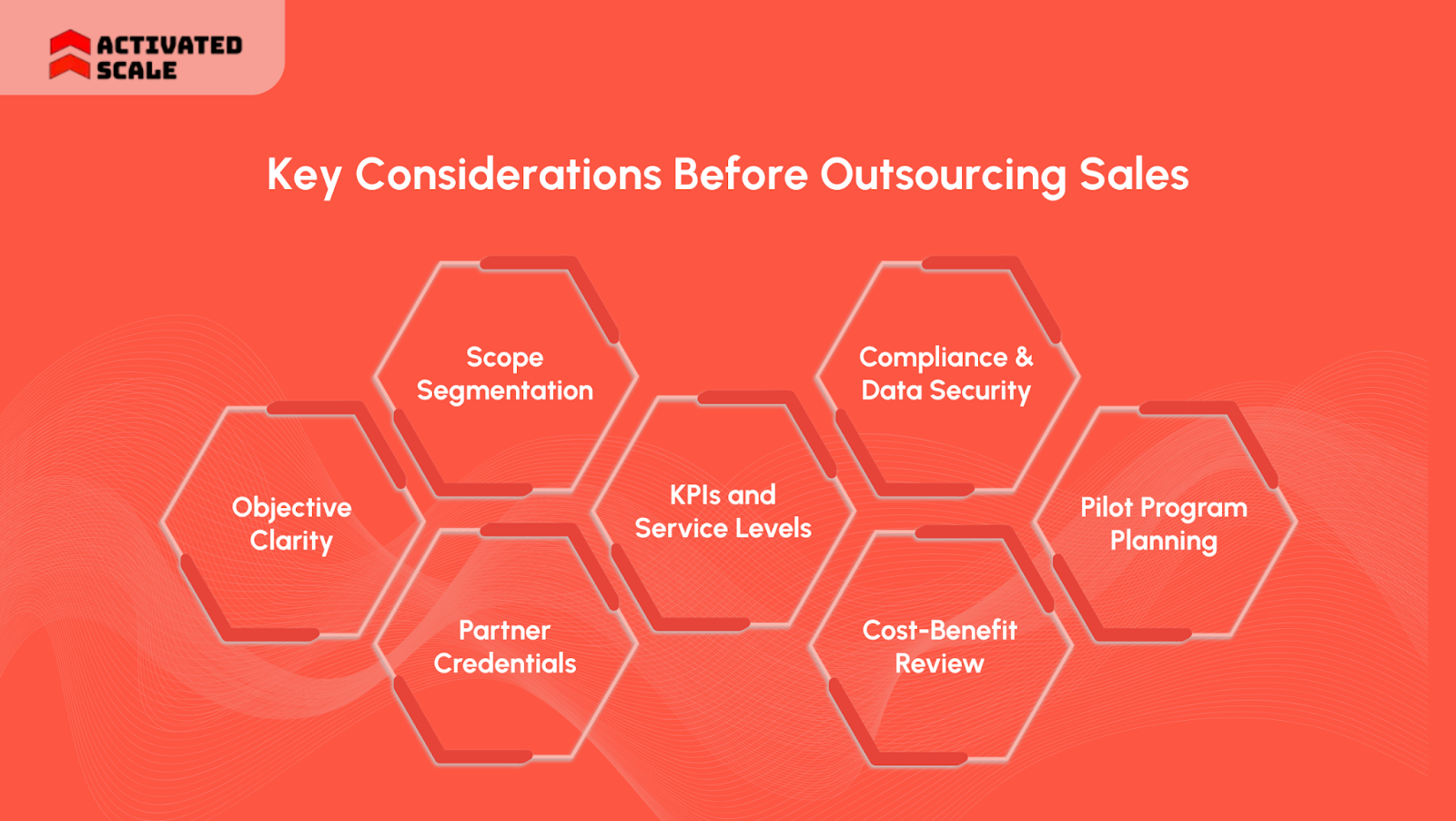
Outsourcing sales calls can open new doors, but stepping in without clear priorities or checks can lead to extra effort or missed goals. Being clear on what matters most helps keep the process focused and accountable from day one. Below covers what to sort out before handing over this part of your sales.
- Objective Clarity: Define measurable sales goals, target segments, and success benchmarks before starting partner outreach or contract negotiations for direct accountability.
- Scope Segmentation: Decide which sales motion components to outsource prospecting, qualification, appointment setting, and pipeline management while retaining control of core strategic functions that drive revenue.
- Partner Credentials: Vet agencies for domain expertise, technology stack compatibility, and evidence of prior success in similar verticals or business models with case references.
- KPIs and Service Levels: Document agreed key performance indicators, conversion rates, reporting formats, and SLA terms to keep outsourced efforts accountable and data-driven.
- Compliance and Data Security: Review how vendors address regulatory obligations, customer data protection, and privacy in relevant geographies, including certifications and audit history.
- Cost-Benefit Review: Model projected spend, ROI, and cash flow impact across contract terms, transition periods, and expansion scenarios before choosing a vendor.
- Pilot Program Planning: Start with a limited-scope engagement or trial phase to validate alignment, adapt processes, and control operational risk before scaling.
How Activated Scale Can Help Businesses Outsource Sales
Activated Scale connects businesses with experienced fractional sales talent, SDRs, AEs, and VPs to support companies that ask, “How do companies outsource sales?”. Its quick placement model is trusted by hundreds for scalable sales solutions.
- Vetting Sales Talent: ActivateScale rigorously screens for proven sales expertise, matching firms with sales professionals who have succeeded at similar average contract values.
- Flexible Placement: Companies outsource sales by hiring fractional SDRs, AEs, or VPs for part-time or full-time campaigns, scaling teams quickly as project needs shift.
- Low-Risk Hiring: Activated Scale enables “try-before-you-hire” contracts, reducing commitment for organizations wondering how companies outsource sales while maintaining control over hiring outcomes.
- Accelerated Onboarding: Clients connect with vetted talent in under seven days, optimizing time-to-ramp and saving key leadership and founder hours all through outsourced sales hiring.
- Workflow Integration: Fractional sales experts work within existing CRMs and outreach platforms, making outsourced sales smoothly fit with current processes and reporting formats.
- Proven Pipeline Impact: Activated Scale helps businesses generate 14+ new meetings a month by deploying experts who refine outbound messaging and consistently open new opportunities.
- Success-Driven Process: From goal-mapping to pipeline analytics, the approach streamlines how companies outsource sales, tracking KPIs and feedback for ongoing process improvement.
In Conclusion
Sales outsourcing can open growth, but it isn’t free from pitfalls. Companies often struggle with unclear expectations, miscommunication, and unforeseen costs that quietly hold back performance. Addressing these obstacles upfront is what turns outsourcing into a strategic advantage rather than a setback.
For those exploring how companies outsource sales more reliably, Activated Scale offers a streamlined solution. By connecting businesses with pre‑vetted US‑based sales talent, they make it simple to expand teams quickly. With transparent pricing, flexible engagement, and fast onboarding, sales hiring becomes less of a gamble and more of a growth driver.
Book a consultation today to see how they can support your startup’s sales growth.
FAQs About How Companies Outsource Sales
1. Can outsourced sales calls adapt quickly to shifting market regulations?
Yes, but only if the provider maintains constant updates and compliance training aligned with industry changes to avoid costly missteps.
2. What safeguards exist to maintain proprietary techniques in outsourced calls?
Contracts with strict confidentiality clauses and limited knowledge sharing protect proprietary approaches during outsourced sales interactions.
3. How to handle the training gap for new product launches in outsourced sales?
Frequent, focused training sessions and direct access to internal product experts keep outsourced reps knowledgeable and confident.
4. How do companies maintain customer relationship continuity with outsourced callers?
Clear handoff protocols and shared CRM tools ensure outsourced teams maintain updated insights and consistent interaction history.
5. What contingencies exist if outsourced sales reps underperform mid-contract?
Most agreements include performance review clauses and quick replacement options to minimize disruption and sustain sales pipelines.
The Ultimate Guide to Hiring a Salesperson!
Get the step-by-step guide to hiring, onboarding, and ensuring success!
_edi.png)
